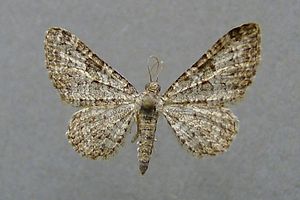Rock lawn bluebell buds
| Rock lawn bluebell buds | ||||||||||||
|---|---|---|---|---|---|---|---|---|---|---|---|---|

Rock-grass bluebell buds ( Eupithecia impurata ) |
||||||||||||
| Systematics | ||||||||||||
|
||||||||||||
| Scientific name | ||||||||||||
| Eupithecia impurata | ||||||||||||
| ( Huebner , 1813) |
The rock- grass bluebell moth ( Eupithecia impurata ), also known as the banded bluebell moth , is a butterfly ( moth ) from the spanner family (Geometridae).
features
butterfly
The wingspan of the moth is 19 to 24 millimeters. The basic color of the forewings is mostly bluish gray to slate gray, but it is very changeable. Depending on the geological formation of the occurrence area, lighter or darker forms can also appear. In the middle of the forewings there is often a relatively wide transverse band, which in some specimens begins dark at the front edge and becomes lighter towards the rear edge. In the case of other shapes, however, this cross band can also be light or dark throughout. There are some dark spots on the front edge. There are several strongly wavy lines in the root and fringing area. Occasionally the forewings are slightly yellowish dusty or speckled. The hind wings appear in the same color as the forewings and are also crossed by several darker lines. On each of the wings there is a blackish center, which is sometimes indistinct.
egg
The egg is initially whitish and shortly before the caterpillar hatches it turns a chocolate brown color. It is slightly flattened, elongated oval and has round depressions.
Caterpillar
Adult caterpillars are light brown in color and have distinct dark diamond spots on their backs .
Doll
The brown-yellow doll has a conical cremaster , which is equipped with eight hook bristles.
Similar species
Eupithecia semigraphata is a little smaller, sometimes also darker. The wide transverse band on the forewings is often indistinct or faded.
As with many flowering species, a reliable determination should be carried out by specialists, and a genital morphological analysis is also advisable, although the differences are extremely small with Eupithecia impurata and Eupithecia semigraphata . The safest way to differentiate results from ex larva breeding, as the caterpillars feed on different forage plants.
Geographical distribution and occurrence
The rock-grass bluebell moth occurs in mountainous areas of western, eastern and southern Europe as far as the Middle East and can even be found at altitudes of 2400 meters. The species prefers dry, rocky lawns and warm, stony slopes.
Way of life
The moths are mostly nocturnal and fly in two generations from May to August and from September to October. They also appear in both sexes in artificial light sources . The eggs are laid individually on the buds of the forage plant. The caterpillars feed on the flowers and fruits of the lawn bellflower ( Campanula cespitosa ), the dwarf bellflower ( Campanula cochleariifolia ) or the round-leaved bellflower ( Campanula rotundifolia ). The pupae overwinter.
Danger
In Germany, the rock-grass bluebell moth is widespread locally, is absent in the northernmost federal states and is listed in category 2 (severely endangered) on the red list of endangered species .
Systematics
Schütze and Weigt named several local subspecies, but their status is controversial.
swell
Individual evidence
- ↑ a b c d Vladimir Mironov: The Geometrid Moths of the World . In: Axel Hausmann (Ed.): The Geometrid Moths of Europe . 1st edition. Volume 4: Larentiinae II. Perizomini and Eupitheciini . Apollo Books, Stenstrup 2003, ISBN 87-88757-40-4 (English).
- ↑ Walter Forster , Theodor A. Wohlfahrt : The butterflies of Central Europe. Volume 5: Spanner. (Geometridae). Franckh'sche Verlagshandlung, Stuttgart 1981, ISBN 3-440-04951-5 .
- ↑ a b c Günter Ebert (Ed.): The butterflies of Baden-Württemberg. Volume 9. Moths VII. Geometridae 2nd part . 1st edition. Ulmer, Stuttgart (Hohenheim) 2003, ISBN 3-8001-3279-6 .
- ↑ Federal Agency for Nature Conservation (Ed.): Red List of Endangered Animals in Germany . Landwirtschaftsverlag, Münster 1998, ISBN 3-89624-110-9 .
- ^ Eduard Schütze: Eupithecien Studies I. (Lep., Geom.). Four German impurata races. Journal of the Vienna Entomological Society, 1951
- ↑ Hans-Joachim Weigt: Flower tensioner observations 10 (Lepidoptera, Geometridae). A new subspecies of Eupithecia impurata HÜBNER, 1813. Dortmund contributions to regional studies, 1989
literature
- Vladimir Mironov: The Geometrid Moths of the World . In: Axel Hausmann (Ed.): The Geometrid Moths of Europe . 1st edition. Volume 4: Larentiinae II. Perizomini and Eupitheciini . Apollo Books, Stenstrup 2003, ISBN 87-88757-40-4 (English).
- Günter Ebert (Ed.): The butterflies of Baden-Württemberg. Volume 9. Moths VII. Geometridae 2nd part . 1st edition. Ulmer, Stuttgart (Hohenheim) 2003, ISBN 3-8001-3279-6 .
- Manfred Koch , Wolfgang Heinicke, Bernd Müller: We determine butterflies. Volume 4: Spanner. 2nd, improved and enlarged edition. Neumann, Leipzig / Radebeul 1976, DNB 780451570 .
Web links
- Lepiforum e. V. Photos
- www.lepidoptera.pl Occurrence in Europe
- www.schmetterlinge-deutschlands.de Endangerment
- Eupithecia impurata at Fauna Europaea. Retrieved June 26, 2012